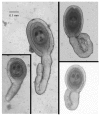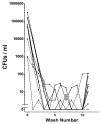Production and Use of Hymenolepis diminuta Cysticercoids as Anti-Inflammatory Therapeutics
- PMID: 29064448
- PMCID: PMC5664013
- DOI: 10.3390/jcm6100098
Production and Use of Hymenolepis diminuta Cysticercoids as Anti-Inflammatory Therapeutics
Abstract
Helminthic therapy has shown considerable promise as a means of alleviating some inflammatory diseases that have proven resistant to pharmaceutical intervention. However, research in the field has been limited by a lack of availability to clinician scientists of a helminth that is relatively benign, non-communicable, affordable, and effectively treats disease. Previous socio-medical studies have found that some individuals self-treating with helminths to alleviate various diseases are using the rat tapeworm (cysticercoid developmental stage of Hymenolepis diminuta; HDC). In this study, we describe the production and use of HDCs in a manner that is based on reports from individuals self-treating with helminths, individuals producing helminths for self-treatment, and physicians monitoring patients that are self-treating. The helminth may fit the criteria needed by clinical scientists for clinical trials, and the methodology is apparently feasible for any medical center to reproduce. It is hoped that future clinical trials using this organism may shed light on the potential for helminthic therapy to alleviate inflammatory diseases. Further, it is hoped that studies with HDCs may provide a stepping stone toward population-wide restoration of the biota of the human body, potentially reversing the inflammatory consequences of biota depletion that currently affect Western society.
Keywords: anti-inflammatory; biological therapeutic; helminth; helminthic therapy; inflammation.
Conflict of interest statement
The authors declare no conflict of interest.
Figures







Similar articles
-
Production of Hymenolepis diminuta in the Laboratory: An Old Research Tool with New Clinical Applications.Methods Mol Biol. 2018;1799:27-38. doi: 10.1007/978-1-4939-7896-0_3. Methods Mol Biol. 2018. PMID: 29956141
-
Practices and outcomes of self-treatment with helminths based on physicians' observations.J Helminthol. 2017 May;91(3):267-277. doi: 10.1017/S0022149X16000316. Epub 2016 May 31. J Helminthol. 2017. PMID: 27240605
-
Murine autoimmune arthritis is exaggerated by infection with the rat tapeworm, Hymenolepis diminuta.Int J Parasitol. 2013 Jun;43(7):593-601. doi: 10.1016/j.ijpara.2013.02.006. Epub 2013 Apr 11. Int J Parasitol. 2013. PMID: 23583716
-
Helminth Therapy - From the Parasite Perspective.Trends Parasitol. 2019 Jul;35(7):501-515. doi: 10.1016/j.pt.2019.04.009. Epub 2019 May 29. Trends Parasitol. 2019. PMID: 31153721 Review.
-
Intestinal worms eating neuropsychiatric disorders? Apparently so.Brain Res. 2018 Aug 15;1693(Pt B):218-221. doi: 10.1016/j.brainres.2018.01.023. Epub 2018 Feb 2. Brain Res. 2018. PMID: 29402395 Review.
Cited by
-
Hymenolepis diminuta-based helminth therapy in C3(1)-TAg mice does not alter breast tumor onset or progression.Evol Med Public Health. 2021 Feb 12;9(1):131-138. doi: 10.1093/emph/eoab007. eCollection 2021. Evol Med Public Health. 2021. PMID: 33738103 Free PMC article.
-
Between a hygiene rock and a hygienic hard place: Avoiding SARS-CoV-2 while needing environmental exposures for immunity.Evol Med Public Health. 2021 Feb 12;9(1):120-130. doi: 10.1093/emph/eoab006. eCollection 2021. Evol Med Public Health. 2021. PMID: 33732461 Free PMC article. Review.
-
COVID-19 morbidity in lower versus higher income populations underscores the need to restore lost biodiversity of eukaryotic symbionts.iScience. 2023 Mar 17;26(3):106167. doi: 10.1016/j.isci.2023.106167. Epub 2023 Feb 9. iScience. 2023. PMID: 36785786 Free PMC article. Review.
-
Selected Molecular Mechanisms Involved in the Parasite⁻Host System Hymenolepis diminuta⁻Rattus norvegicus.Int J Mol Sci. 2018 Aug 17;19(8):2435. doi: 10.3390/ijms19082435. Int J Mol Sci. 2018. PMID: 30126154 Free PMC article. Review.
-
Multiple sclerosis and the microbiota: Progress in understanding the contribution of the gut microbiome to disease.Evol Med Public Health. 2022 Jun 13;10(1):277-294. doi: 10.1093/emph/eoac009. eCollection 2022. Evol Med Public Health. 2022. PMID: 35747061 Free PMC article. Review.
References
-
- Bono-Lunn D., Villeneuve C., Abdulhay N.J., Harker M., Parker W. Policy and regulations in light of the human body as a ‘superorganism’ containing multiple, intertwined symbiotic relationships. Clin. Res. Regul. Aff. 2016;33:39–48. doi: 10.1080/10601333.2016.1210159. - DOI
LinkOut - more resources
Full Text Sources
Other Literature Sources

